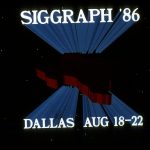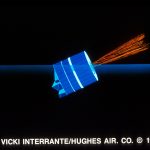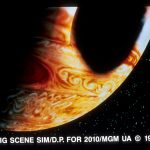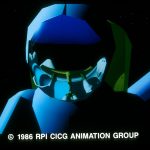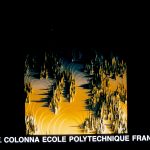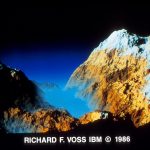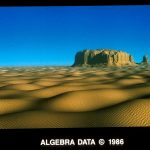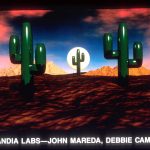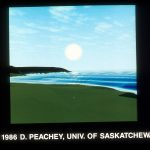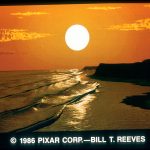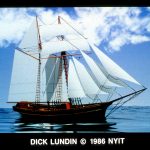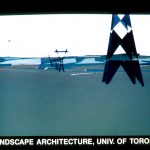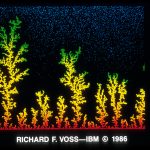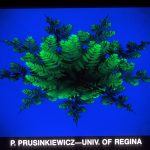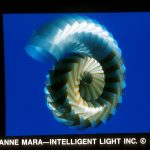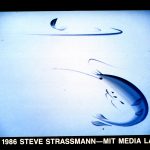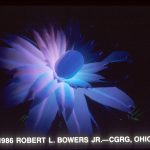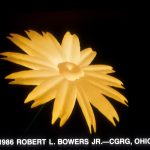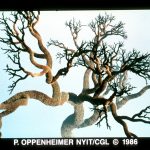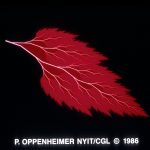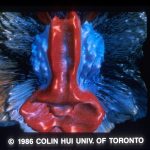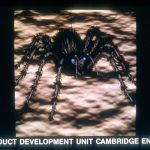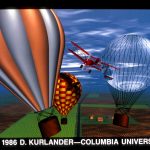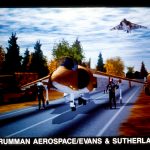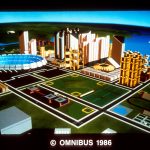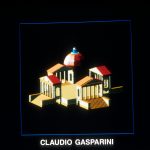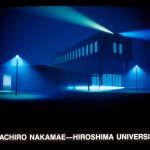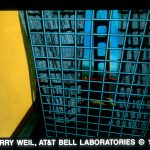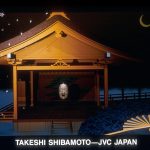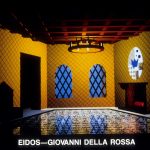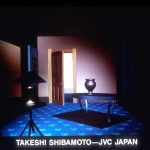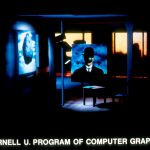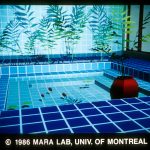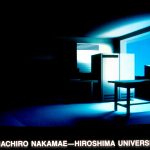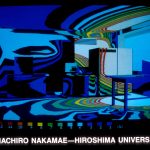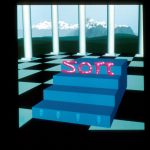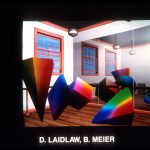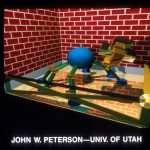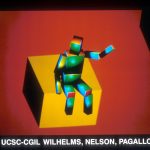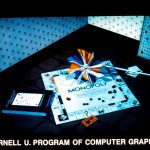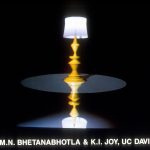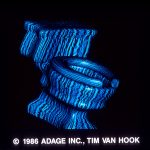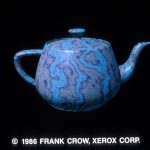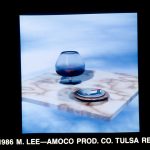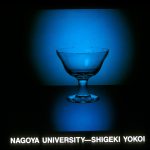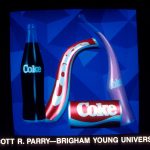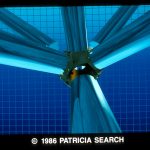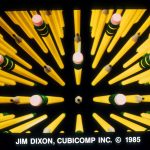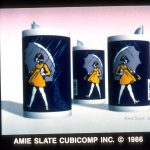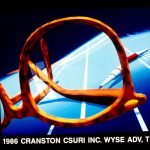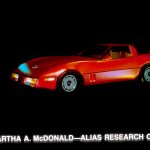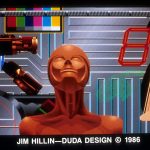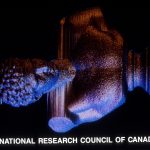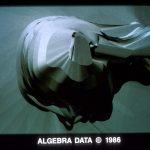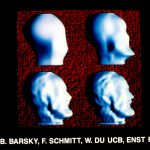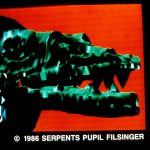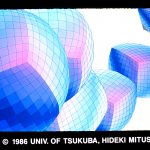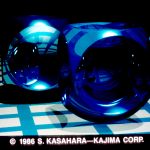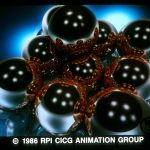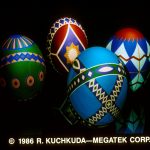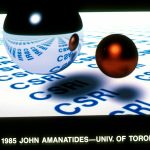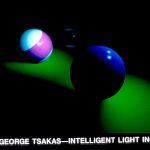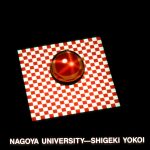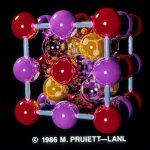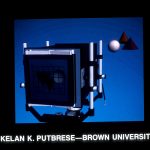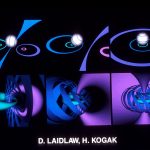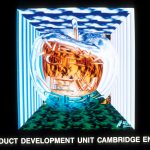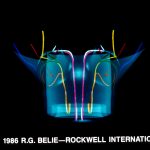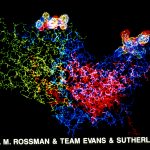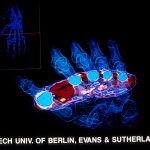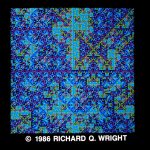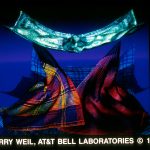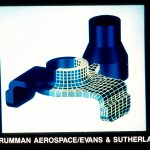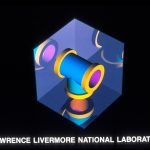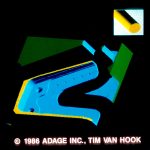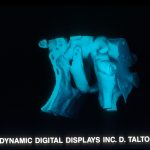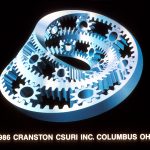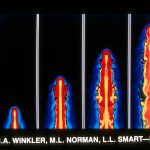“1986 Technical Slide Set”, 1986
Title:
- 1986 Technical Slide Set
Year:
- 1986
Conference:
Description:
- John Huszar, ISSCO, 10505 Sorrento Valley Road, San Diego, CA 92121; SIGGRAPH ’86.
- Vicki Interrante, Hughes Aircraft Co/ Radar Systems Group, 11706 Cyharnock Rd., Los Angeles, CA 90066; Williams Patent Trial Simulation. The image was developed by Vicki Interrante, on a Megatek Merlin 9200 using the Apprentice software package. This slide is taken from a real-time simulation of a NA TO-Ill satellite in transition between elliptical transfer orbit and geosynchronous orbit. The animation was developed for a patent trial.
- Craig Upson and Larry Yaeger, Digital Productions, 3416 So. La Cienega Blvd., Los Angeles, CA 90016; Jupiter/2010. This digital scene simulation (SM) for 2010/MGM UA was produced on a Cray X-MP using our proprietary software, DP3D, which is a three-dimensional rendering system. The slide depicts a large scale simulation of planetary cloud motion on Jupiter.
- Phil Getto, David Breen, Tony Apodaca and Linda Roy, RPI CICG Animation Group, Communications Center, Room 121, Troy, NY 12180-3590; Shuttle Vision. The CLOCKWORKS integrated ray tracing renderer (BART), animation system (CORY), superquadric modeler (TIM) by the RPI CICG staff. Hardware used included Data General MV 10000, Raster Technologies Model 1 / 20 and a Dunn 631 camera.
- JF. Colonna, LACTAMME Ecole Polytechnique, 91128 Palaiseau Cedex, France; Recursive 6. The image is medium resolution (5 I 2×5 I 2 256 colors) with depth cueing, shadows, self-shadows. This is part of a video movie about the Flandel Crot set.
- Richard F. Voss, IBM, Thomas J. Watson Research Center, P.O. Box 218, Yorktown Heights, NY 10598; Untitled.
- Peter W atterburg, 773-42A Savannah River Laboratory, Aiken, SC 29808; Enchanted Mesa. The image was ray traced at I 800x 1200 resolution on a MicroVAX II and produced on a Dicomed film recorder. The mesa and sand dunes were created using variations of algorithms presented by Richard Voss for making fractal terrain.
- John Mareda and Debbie Campbell, Sandia Labs, P.O. Box 5800, Div 2644, Alb. NM 87185; Desert Sunset. Scene software written by Peter Watterburg. This slide was generated using in house ray tracing software. Output is 12 17×811 resolution and was generated on a Dicomed film recorder.
- Darwyn Peachey, 86 Commerce Bldg., Dept. of Computational Science, University of Saskatchewan, Saaskatoon, Sadk, Canada S7N 0W0; Waves on Babbage Beach. This image of ocean waves on a beach was produced by the PIXIE 3D rendering system, as described in “Modeling Waves and Surf” in the proceedings of SIGGRAPH ’86.
- William T. Reeves, Pixar, P.O. Box 13719, San Rafael, CA 94913-3719, and Alain Fournier, University of Toronto; Beach at Sunset. Computer Graphics/October 1986/Volume 20/Number 5/195
- Dick Lundin, New York Institute of Technology, Computer Graphics Laboratory, Box 170, Old Westbury, NY 11568; CWorthy. 1024×960 picture created using z-buffer-based rendering and shadow software in conjuction with Genisco frame buffers interfaced with VAX 11 / 785 computer. Reflection created by ray tracing a texture map. Tom Shermer created clouds using algorithm from Geoffry Gardner (SIGGRAPH ’84 and ’85 proceedings).
- John Danahy, Shannon McKenzie and the Cynamic Graphics Group, Computer Systems Research Institute, Landscape Architecture, University of Toronto, 230 College Street, Toronto, Ontario, Canada M5S I A I; Transmission•Line Visual lmact. Visual imact assessment of a hydro transmission line proposal for the Niagara Escarpment Commission, Ontario, Canada. Three dimensional terrain and towers modeled on an Ikonas 3000 frame buffer and VAX 11 /780 II using “3D” display program written in “C.”
- Richard F. Voss, IBM, Thomas J. Watson Research Center, P.O. Box 218, Yorktown Heights, NY 10598; Untitled.
- P. Prusinkiewicz, Department of Computer Science, University of Regina, Regina, Saskatchewan S4S 0A2 Canada; Fibonacci plant. A “plant” generated by an Lsystem. Distances between branches conform to the Fibonacci series, often present in nature. The image was photographed directly from a SUN 2/ 120 color monitor.
- Jeanne Mara, Intelligent Light Inc. P.O. Box 65, Fairlawn, NJ 07410; Nautz. Software: Intelligent Light; hardware: Apollo 3D polygon based algorithm demonstrating transparency.
- Steve Strassmann, MIT Media Laboratory, 20 Ames St., Cambridge, MA 02139; Shrimp and Leaf. Brush strokes are simulated by modeling the changes to each bristle as the brush moves across the page. The algorithm was implemented in Lisp on a Symbolics 3600 Lisp Machine.
- Robert L. Bowers Jr., J. Gomez and W. Carlson, Computer Graphics Research Group, The Ohio State University, 1501 Neil, Columbus, OH 43201; Untitled. The application of multiple lighting sources as main color indicator using local software (sen-assembler). Primary color results from color lighting rather than from polygon or vertices color specification. In-house software, VAX 11 / 780 and E&S PS 300.
- Robert L. Bowers Jr., J. Gomez and W. Carlson, Computer Graphics Research Group, The Ohio State University, 1501 Neil, Columbus, OH 43201; Untitled. The application of multiple lighting sources as main color indicator using local software (sen-assembler). Primary color results from color lighting rather than from polygon or vertices color specification. In-house software, VAX 11 / 780 and E&S PS 300.
- Peter Oppenheimer, New York Institute of Technology, Computer Graphics Laboratory, Box 170, Old Westbury, NY 11568; Views II. This 3D fractal tree is generated by a stochastic parametric modeling program. The orientation and scale of each branch is randomly perturbed. A VAX 11 / 780 computer was used with output resolution of 2048 x 1920.
- Peter Oppenheimer, New York Institute of Technology, Computer Graphics Laboratory, Box 170, Old Westbury, NY 11568; Fallen Leaf. This exaggerated image of vein branching in a fall leaf was generated by a fractal branching program. The external boundary shape is the limit of growth of the internal veins. A VAX 11 /780 computer was used with output resolution of 5 I 2×480.
- Colin Hui, Dynamic Graphics Project, University of Toronto, 10 King’s College Rd., Room 2002, Toronto, Ontario, Canada, M5S I A4; Ugman. This image was created using relief and texture mappings. It was rendered on an Adage/Ikonas RDS-300 raster display system attached to a VAX 11 / 780 host computer. Colin Hui artist, with in-house software by Colin Hui, Tom Nadas and John Amanatides.
- G.S.P. Miller, DUCT Development Unit, Cambridge University, Wolfson College, Cambridge, England CB39BB; Hanging by a thread. Particle system with hidden line removal. Jittered hair growth algorithm. Computer: Prime 250 SIGMEX framestore. Gavin Miller: concept and software; Jon Hunwick: spider design.
- David Kurlander, 450 Computer Science Building, Columbia University, New York, NY 10027; Haute Air. This image illustrates the application of a wide variety of two and three variable texturing functions to ray tracing. It was generated at a resolution of 2048 x 1536 on an IBM 4381 and recorded with a Matrix Instruments QCR D4/2.
- Gregory McFarlane, Evans and Sutherland, P.O. Box 8700, 580 Arapeen Drive, Salt Lake City, UT 84108; Harrier Jets. This scene, depicting two McDonnell Douglas AV-8B “Harrier” vertical short takeoff and landing aircraft, demonstrates the high level of detail and scene realism possible with the Evans & Sutherland CT6 system. CT6 systems are used in both engineering and training applications. Training possibilities include tactical, formation flight, in-flight refueling and low level nap-of-earth operations for rotary and fixed wing aircraft. Visual and sensor systems also may be integrated. Advanced hardware texture improves scene realism and provides pilots with essential height and speed cues for low altitude flight training.
- Omnibus Computer Graphics Inc. 508 West 57th Street, New York, NY 10019; ESPN City. Image computed on a VAX 11/780 using Omnibus’ propietary software ‘Prisms’ for data generation and image composition on lkonas RDS-3000, and ‘Crystal’ for all rendering effects that may includ _ e: . Gouraud/ Phong shading, texture, bump, reflect10n mapping. ‘Prisms’ by Omnibus’ R+D Group, ‘Crystal’ by Dave Gordon/ Carl Frederick.
- Claudio Gasparini, PolitecnicoF AC Architettura, Computer Graphics Lab, Via Bonardi, 3, 20155 Milano, Italy; Palladio’s Villa Rotunda. Use of computer graphics in architectural study of historical buildings. Visualization of project’s stages and architectural analyses.
- Eihachiro Nakamae, Hiroshima University, Saijo, Higashihiroshima, Hiroshima 724 Japan; The beams of light in the foggy night. Used facilities: Computer-TOSBAC DS-600, color crtG RA PH ICA M508. The luminance distribution of the street lamps, headlights and the beacons in fog are taken into account.
- Jerry Weil, AT&T Bell Laboratories, 600 Mountain Ave, Murray Hill, NJ 07974; Irony. A system was developed for modeling cloth objects both for static images and for animation. A special purpose ray tracer was used for rendering the cloth image.
- Takeshi Shibamoto, Audio Engineering Research Center, Victor Company of Japan, LTD., Shimotsuruma, Y amato-shi, Kanagawa-ken, 242 Japan; The Noh Space II. Made using a VAX 11 /750 and JYC’s 3Dgraphics software by Takeshi Shibamoto, Makoto Kobayashi, Masahiro Araoka, Masanori Kono, Yumi Shibata and Tsuyoshi Toyokawa.
- Giovanni della Rossa, Eidos specialisti in eidomatic Spa, Via Fontana, 16, 20122 Milano, Italy; Untitled. Solid modeled, ray traced castle interior realized for Rai Italian national television. Analytical texturing and two light sources. Data General MY 8000 II, Apollo DN 660, E&S PS 300 and a 3-D Polhemus digitizer were used. The software was RA YT and MODEL by eidos.
- D. Thalmann, Department d ‘lnformatique et Rech. Operationnelle, University of Montreal, CP 6128, Succ. A, Montreal, Canada H3C 3.17; Traditional Room. Hardware used is a DEC VAX 11 /780 and a Raster Technologies One/80. The software is the MIRANIM system developed by N. and D. Thalmann. Illumination is based on spotlights. R. Racine did the design.
- Michael F. Cohen, Philip J. Brock and David S. Immel, Cornell University Program of Computer Graphics, 120 Rand Hall, Cornell University, Ithaca, NY 14853; Artist Studio Lights Off. The image was rendered using diffuse radiosity software run on a VAX 11 / 780 and displayed on a 5 l 2x480x24 bit Grinnell frame buffer.
- D. Thalmann, Department d’Informatique et Rech. Operationnelle, University of Montreal, CP 6128, Succ. A, Montreal, Canada H3C 3J7; Swimming Pool. Hardware used is a DEC VAX 11 /780 and a Raster Technologies One/ 80. The software is the MIRANIM system developed by N. and D. Thalmann. Illumination is based on spotlights. M. A. Allaire did the design.
- Eihachiro Nakamae, Hiroshima University, Saijo, Higashihiroshima, Hiroshima 724 Japan; A computer room with a clear sky. Used facilities: Computer-TOSBAC DS-600, color crtG RAPHICA M508. The luminance distribution of the clea,r sky and the interrefrection of light from walls and objects are taken into account.
- Eihachiro Nakamae, Hiroshima University, Saijo, Higashihiroshima, Hiroshima 724 Japan; Daylight factors with a clear sky. Used facilities: Computer-TOSBAC DS-600, color crtG RA PHICA M508. The color belts show the distribution of daylight factors which show the percentage of illuminance to the unobstructed illuminance.
- D. Hankinson, D. Jevans, David L. Maulsby, C. McPhecters, B. Wyvill and G. Wyvill, Dept. of Computer Science, University of Calgary, 2500 University Dr. NW, Calgary, Canada T2N IN4; Nigitama. A “soft” object (of blobby molecules), rendered as a polygon mesh coincident with each iso-surface (ie. each letter of “soft”) is draped over and conforms to an ordinary polygon mesh (the stairs).
- David Laidlaw, Barbara Meier, Computer Science Department, Brown University, Box 1910, Providence RI 02912; Color Choreography. Four color spaces, the RGB cube, the Ostwald double cone, the HSY hexcone and the CIE color space are represented in this image modeled and rendered on Vaxen using software developed by the Brown University Graphics Group.
- John W. Peterson, Department of Computer Science, The University of Utah, 3160 MEB, Salt Lake City, UT 84112; Bug. The image was modeled using an object-oriented modeler implemented in Lisp. It was rendered at 5 I 2×5 l 2 resolution (with adaptive anti-aliasing) by a ray-tracing program on an Apollo workstation.
- Jane Wilhelms, Kathryn Nelson and Giulia Pagallo, UCSC Computer and Information Sciences, Applied Sciences Building, Santa Cruz, CA 5064; Deua Bodies. Done on an E&S PS 340 using “Deua” software by Wilhelms for modeling articulated bodies in motion using dynamic analysis.
- Eric Haines, Cornell University Program of Computer Graphics, 120 Rand Hall, Cornell University, Ithaca, NY 14853; Homo Ludens. The image illustrates texturing and tiling techniques in a ray tracing system and was computed on a VAX 11 /780 and displayed on a l 280x I 024×24 bit Rastertek frame buffer.
- Murthy N. Behetanabhotla and K.I. Joy, College of Engineering, Dept. of EE and CE, Division of Computer Science, University of California, Davis CA 95616; The lamp is reflected in a plane. This slide was produced by ray tracing B-spline surfaces with the technique described in the paper, “Ray Tracing Parametric Surface Patches Utilizing Numerical Techniques and Ray Coherence” by Joy and Behetanabhotla in SIGGRAPH ’86 proceedings.
- Tim Van Hook, Trancept Systems, 521 F Uwharrie Ct. Raleigh, NC 27606; Seismic John. This image was generated on an Adage/ Ikonas 3000 display system using a microcoded B-spline surface rendering with texture mapped seismic data.
- Frank Crow, Computer Science Laboratory, Xerox Corp., Palo Alto Research Center, 3333 Coyote Hill Road, Palo Alto, CA 94304; Immaterial Teapot. This is the classic teapot data from Martin Newell with a bottom added (for holding water) and the lid resized (to prevent its falling inside). The texture function is based on work by Ken Perlin. Two different texture functions are mediated by a third function which chooses between the two. All three functions are derived from the same base function to ensure that the seams align properly. Computed in a bit over two hours on a Dorado, the image has 1024 by 768 pixels. The slide was made on a Dunn camera.
- Mark Lee, Amoco Production Company, Tulsa Research Center, P.O. Box 3385, Tulsa OK 74I02; Mandrill Wine. The image was produced using a distributed ray tracing algorithm. Produced on an IBM 3090, Raster Technologies One/25 and a Dunn Instruments 632 camera.
- Shigeki Yokoi, Nagoya University, Department of Information Engineering, Faculty of Engineering, Nagoya University, Furo-cho, Chikusa-ku, Nagoya Japan; Glass Container. This picture was generated by the ray tracing algorithm. Programmer: Ko-ichi Horiwuchi.
- Scott R. Parry, Brigham Young University, P.O. Box 2261, La Grange, GA 30241; Cans and Bottles. The distorted can and bottle were made by applying free-form deformations to the undistorted models. The image was displayed using MOVIE.BYU on a 512 resolution Lexidata frame buffer. See “Free-Form Deformation of Solid Geometric Models” in the proceedings of SIGGRAPH ’86.
- Patricia Search, Rensselaer Polytechnic Institute, Save 4707, Troy, NY 12180; Mystrigue. Real or reflection’! This ray traced scene contains only three “real” objects. All other images are mirror reflections of the environment. Geometric modeling was done with superquadrics and ray tracing was accomplished with a new algorithm written by Philip Getto and Gary Lorig. “Mystrigue” includes the human perceptual aspect of visualization as an integral part of the process of mathematically rendering geometric forms. Made with a Data General MY 10000.
- Shari Folz and Jim Dixon, Pacific Data Images, 1111 Karlstad, Sunnyvale, CA 94089; Depth of Feel.
- Amie Slate, Cubicomp, 3165 Adeline St., Berkeley, CA 94703.; Salt shakers. The label was traced and rendered, and then texture mapped. The shadows are polygons traced by hand from the light source perspective and then transformed to the correct plane.
- Michelle L. Amato, Cranston/ Csuri Productions, Inc., 1501 Neil Avenue, Columbus, OH 43201, Wyse Advertising and TRW; The Best Idea In The World. Technical achievements include the development of meshing, mobile gears and refractions/ reflections through the eyeglasses. Hardware used includes Pyramid Technologies, VAX 11 / 750’s and 11 / 780’s, E&S PS 300, SUN Microworkstations and in-house frame buffers and software.
- Martha A. McDonald, Alias Research Corp., 111 Queen St. E., Toronto, Canada M5C I S2; Untitled.
- Jim Hillin, DUDA Design Inc., 16707 Sunset Blvd. Pacific Palisades, CA 90272; Input. Illustrator: Jim Hillin; art director: Pamela Hughes; publication: AV Video magazine used for cover of issue on inputting devices. This was created with an IBM PC, Number Nine color card, Kurta type I tablet, Electrohome 512 res. RG B monitor employing Time Arts’ Lumena v2. I paint software. Imaging was accomplished with Time Arts’ QCR driver and a Matrix Instruments QCR with an 8x IO film back.
- K. B. Evans, Intelligent Systems Laboratory, Building A-50, National Research Council of Canada, Montreal Rd, Ottawa, ONT KIA -RS Canada; Untitled. Real time lighting model (Phong) using surface normal and look up table manipulations on a Greek statue (200 x 450 control points). Light sources are tablet controlled; the data was captured by a 3D laser scanner developed in our lab.
- Markku Metsamaki, Algebra Data, Isokaari 8, SF-00200 Finland; Iron Man. SDRC/GEOMOD CAD base programs on VAX 11 /750 with own modifictions in use. Virtual sculpting of a human face combining CAD with stereoimaging and a new method of Europian style soft coloring as a part of an art project.
- Brian A. Barsky, Francis J.M. Schmitt and Wen-Hui Du, University of California, Computer Science Division, Berkeley, CA 94720; Victor Hugo. This sequence of four raster images illustrates successive iterations of the adaptive subdivision method for surface-fitting from sampled data developed by the authors in the SIGGRAPH ’86 conference proceedings. The database was obtained from a real bust of Victor Hugo analyzed in cylindrical coordinates using an automatic threedimensional digitizing system developed at ENST Paris. The images were computed on a VAX 11 /780 under VMS, stored in a SINTRO-ALCATEL 3x512x512x8 frame buffer, and displayed on a Tektronix 690 monitor.
- Tomas J. Filsinger, UCLA Center of Experimental Computer Science, 11706 Charnock Rd., Los Angeles, CA 90066; The Monster. Image produced by CATscaning a plastiline model of the head and generating a mesh using the contours and a mosaic program of C.A.P.S. A 7000 polygon object resulted.
- Hideki Mitsui, The University of Tsukuba, Art and Design Course, Sakuramura, lbaraki, Japan 305; Transmigration-IV. Used Facom M-200 computer and 3D refresh type display.
- Shinichi Kasahara, Information Processing Center, Kajima Corporation, 1-1 Nishi-shinjuku 2-chome Shinjuku-ku, Tokyo, 160 Japan; Two kinds of dimples. The image represents a metalic object and a transparent object with five dimples each. These objects were modeled with CSG and rendered with a ray tracing algorithm. The image was produced on an IBM 4361 and displayed on an 1B M 5080 at 512 resolution.
- Phil Getto, David Breen, Tony Apodaca and Linda Roy, RPI CICG Animation Group, Communications Center, Room 121, Troy, NY 12180-3590; Terrain. The CLOCKWORKS integrated ray tracing renderer (BART), animation system (CORY), superquadric modeler (TIM) by the RPI CICG staff. Hardware used included Data General MY 10000, Raster Technologies Model I/ 20 and a Dunn 631 camera. Modeling and characteristics by David Breen.
- Roman Kuchkuda, Megatek Corp. 9645 Scranton Road, San Diego, CA 92121; Eggs on Display. Shadows and reflections make this space traced image truly three dimensional. It was computed on a VAX 11 /780 and displayed on a Megatek 9200.
- John Amanatides, Department of Computer Science, University of Toronto, Toronto, Ontario, Canada, M5S IA4; Untitled. This image was rendered using a cone tracing algorithm. This allows for the anti-aliasing of the objects and the floor texture, the dull reflections and the fuzzy shadows. It was rendered on an Adage/ lkonas RDS-300 raster display system attached to a VAX 11 / 780 host computer.
- George Tsakas, Intelligent Light Inc., P.O. Box 65, Fairlawn, NJ 07410; Pool Balls. Software: Intelligent Light, hardware: Apollo 3D polygon based algorithm demonstrating soft shadows without ray tracing.
- Shigeki Yokoi, Nagoya University, Department of Information Engineering, Faculty of Engineering, Nagoya University, Furo-cho, Chikusa-ku, Nagoya Japan; Star Ruby. Asterism effect is owing to light dispersion caused by inclusions inside ,, star ruby. We developed an algorithm to render the effect by introducing the diagram called the ray distribution map. Programmer: Ko-ichi Horiwuchi.
- Melvin L. Pruiett, Los Alamos National Laboratory, Los Alamos, NM 87545; Crystal Structure of a Metal Alloy. Data from Fred Mueller.
- Kelan K. Putbrese, Brown University Box 1910, Providence, RI 02912; Image through Viewcamera. In-house modeling and rendering software, running on a DEC VAX 11 / 780 with 4.2 BSD Unix was used to produce the image. Lexidata and E&S hardware was used to design the scene. The image was recorded using a Matrix QCR film recorder.
- David Laidlaw and H. Kogak, Brown University Box 1910, Providence, RI 02912; Sphere to Hypersphere. The ordinary sphere can be sliced into circles by parallel planes. Similarly, the hypersphere can be divided into tori that exist in four dimensions. The top images show circles on the sphere stereographically projected onto a two dimensional plane. The bottom images show corresponding tori on the hypersphere projected onto three dimensional space. The images were created on Vaxen using software developed by-David Laidlaw, Huseyin Kogak and the Brown University Graphics Group.
- G.S.P. Miller and Jon Hunwick, DUCT Development Unit, Cambridge University, Wolfson College, Cambridge, England CB39BB; New York, New York. Fast ray tracing of curved surface with texture antialiasing (only really works for convex objects, but it’s a nice picture). Computer: Prime 250, SIGMEX framestore. Gavin Miller: artist, programmer, texture designs; Jon Hunwick: Apple design.
- R.G. Belie, Rockwell International, Rocketdyne Division, 6633 Canoga Avenue, Canoga Park, CA 91304; Flow Ribbons in the Hot Gas Manifold of the Space Shuttle Main Engine. Computer graphics generated ribbons mark typical flow paths through a design interation of the Space Shuttle Main Engine Hot Gas Manifold (HGM). In this view from the top of the HGM, hydrogen fuel enters the fuel bowl section and is turned 180 degrees to flow back up the outside of the turbine housing. Finally the flow turns to exit through the two transfer tubes. The flow boundaries are depicted as transparent, glassy looking structures to aid viewer orientation. The ribbons themselves show the direction and orientation of the flow. Colors indicate starting location. The computational\ fluid dynamics codes were developed by a joint NASA/ AMES Research Center and Rocketdyne team. The CFO study of the HGM was conducted by James L.C. Chang and Steve Baarson with flow visualization by Gary Belie, all of Rocketdyne. The entire effort was sponsroed by the NASA Marshall Space Flight Center.
- Michael Rossman and team, Evans and Sutherland, P.O. Box 8700, 580 Arapeen Drive, Salt Lake City, UT 84108; Human Virus. The research team headed by Michael Rossman successfully completed the first mapping of a human virus; a virus responsible for the common cold. With major and side chqins identified, the shape and structure of one complete protomer unit was revealed, consisting of four Vital Proteins (VP). VPI is coded blue, VP2 and VP4 in green and VP3 in red. The shell of the virus is made up of 60 identical protomer units, forming a spherical highly structured “container” for the RN A nucleus. Rotating the protomer unit reveals the theoretical host cell receptor site, a 25-angstrom deep canyon of the surface of the structure. Neutralizing antibody binding sites the sites to which antibodies bind and stop infectivity are highlighted with van der Waals dot surfaces.
- National Han sen ‘s Disease Center and Evans and Sutherland, P.O. Box 8700, 580 Arapeen Drive, Salt Lake City, UT 84108; Interactive Kinematic Simulation of a Human Hand. The National Hansen’s Disease Center/ Louisiana State University Center for Biomedical Research has developed an interactive kinematic simulation of a human hand in order to allow simulated experimental surgical procedures to be performed and resulting mobility to be evaluated. The skin, bone and tendon boundaries are outlined by a curve tracing algorithm. These outlined images are then combined to display the complete hand image.
- Richard Q. Wright, Winchester School .of Art and 18 M UK Scientific Centre, . 12 Romsey Rd. Winchester, Hants, S023 8TP England; 1,2,3,0,0,2, l,2,2,1,2,6,2,1,2,3, 0,0,6,6,2,2,2,2,1,1. Example of an image produced by the program “CELLS,” a mathematically-based language system for the visual arts. The numbers in the title refer to the input parameters. Displayed on an IBM 5080.
- Jerry Weil, AT&T Bell Laboratories, 600 Mountain Ave., Murray Hill NJ 07974; Money for Nothing. A system was developed for modeling cloth objects both for static images and for animation. A special-purpose ray tracer was used for rendering the cloth image.
- PDA Engineering and Evans and Sutherland, P.O. Box 8700, 580 Arapeen Drive, Salt Lake City, UT 84108; Untitled. A finite element mesh is superimposed over a solid geometric rendering of a cylinder pivot as displayed on th PS 340 Color Static Raster Display.
- Gary Laguna, Lawrence Livermore National Laboratory, P.O. Box 808, LI 25, Livermore, CA 94550; Untitled. This slide demonstrates the utility of showing multiple views in a single image by inserting reflective surfaces. This image was rendered using our ray tracing software implemented in the Tl PS-I/ LLNL Solid Modeler which runs on a Cray-I .
- Tim Van Hook, Trancept Systems, 521 F. Uwharrie Ct., Raleigh, NC 27606; Untitled. This image was generated on an Adage/ lkonas 3000 display system from an NC milling path courtesy of Northrop Corporation using a microcoded real-time CSG subtraction of solid objects.
- P. Decuypere, Dept. of Computer and Information Science, GRASP Laboratory, Univ. of Pennsylvania and S.M. Goldwasser, R. A. Reynolds, D.A. Talton, E.S. Walsh, Dynamic Digital Displays, Inc., University City Science Center, 3508 Market St., Suite 257, Philadelphia, PA 19104; High Resolution 3-D Image of the Cervical Spine. A new algorithm for the 3-D display of anatomical objects as imaged by Computed Tomography (CT) scanners has been developed. The new algorithm retains the full ( 12-bit) densities throughout the rendering process, thereby obtaining a sub-voxel estimate of the true surface location. The object is a smaII volume of the spine.
- Michelle L. Amato, Cranston/Csuri Productions, Inc., 1501 Neil Avenue, Columbus, OH 43201; Mobius Gears. An innovative advancement showing actual “MobitJs” that twist inside out as the gears mesh and turn. Hardware used includes Pyramid Technologies, VAX 11 /750’s and 11 /780’s, E&S PS 300, SUN Microworkstations and in-house frame buffers and software.
- Karl-Heinz, A. Winkler, M.L. Norman and L.L. Smart, Los Alamos National Laboratory, Los Alamos, NM 87545; Hypersonic gas flow. Fluid calculations from Cray supercomputer displayed on real time Gould system. This graphics project is being developed to study the use of image processing hardware and software in physics calculations.
The technical slide set represents examples of the latest work in computer graphics demonstrating technical expertise. Each slide is printed here in black and white to facilitate locating’ information about the images. The full color 35mm slide set can be ordered from: ACM order department, P.O. Box 64145. Baltimore, MD 21264; 1-800-342-6626. The ACM order number for the SIGGRAPH ’86 technical slide set is 915860.
Publication Documents:
1986 Technical Slide Set Images:
